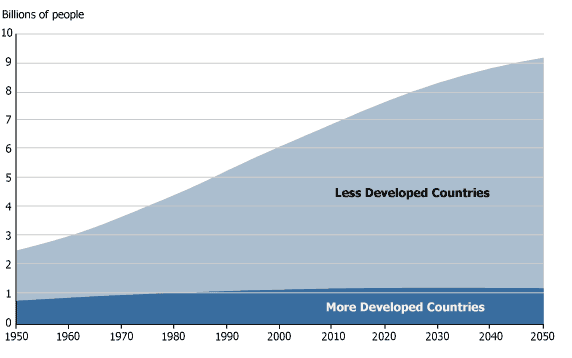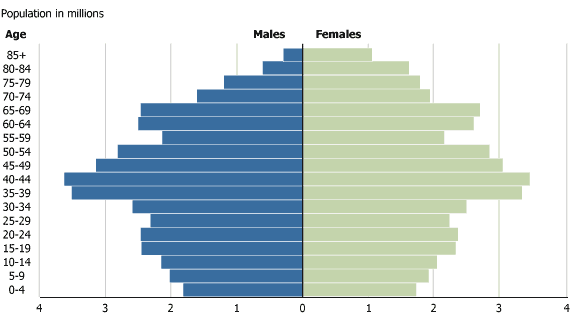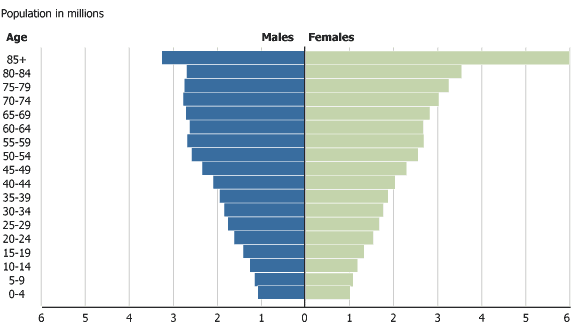Carl Haub
Demographer Emeritus

This article was originally printed in the Public Policy & Aging Report 17, no. 4 (2007).
(April 2008) In the latter half of the last century, the world’s developed nations completed a long process of demographic transition.1 The field of demography describes this demographic transition as a shift from a period of high mortality, short lives, and large families to one with a longer life expectancy and far fewer children.
This transformation took many centuries in Europe and North America as people moved from farms to cities; basic public health measures steadily reduced the risk of contagious disease; and modern medicine prolonged lives to unprecedented lengths. In developing countries, this demographic transition is certainly underway, though these countries vary widely at their places along the spectrum.
Very low birth rates and the resultant population decrease have received considerable media attention, particularly in Europe and parts of eastern Asia. In the past, when demographers projected national and global populations, the projections commonly assumed that birth rates would decline worldwide but only to the “two-child” family, i.e., two children per woman or per couple on average. An assumption that fertility would fall below this rate would have some unpleasant consequences: a decrease in population size and a population top-heavy with retired seniors who would depend upon the social taxes paid by a dwindling number of younger workers. While it may not have been desirable to project such a gloomy scenario in the past, this is exactly what has transpired in many countries.
Today, the global population has come to what we may call a great “demographic divide.” Very low birth rates have inflicted long-lasting alterations upon the age structure of Europe, although the effect is more severe in some countries than in others. A real battle has ensued over retirement age. Governments know that the age at which public pensions can be collected should be raised, even though the idea meets frequent public resistance. Labor force shortages are recognized, particularly among less desirable service occupations, but there is little agreement on how to resolve them.
Immigration is one obvious solution and there is no shortage of those willing to migrate to help solve it. But that solution often leads to a fear of losing national identity. Anxiety over immigration is different in Europe than in North America since most Europeans do not see themselves living in multicultural societies. Japan, in particular, is especially resistant to an immigration solution. Debates over how to solve labor force issues range from providing remedial training where it may be needed, to greater inclusion of women in the workforce, to simply raising the birth rate. In Germany, the rallying cry of those opposed to the immigration solution has been “Kinder statt Inder” (Children instead of Indians).
Figure 1 presents the demographic divide with dramatic clarity. It is apparent that, for all practical purposes, all of world population growth is taking place in the developing countries, and it is likely to continue to do so. Of this, there is little doubt. Today, there are about 1.2 billion people living in developed countries and 5.4 in developing countries. By 2050, the number living in developed countries will not have changed but there will be 8 billion in the developing countries.2 In the developed countries, the 1.2 billion number remains constant only because population growth in the United States offsets decreases in Europe and Japan.
Figure 1
World Population Growth, 1950-2050
 Source: United Nations, World Population Prospects as Assessed in 2008.
Source: United Nations, World Population Prospects as Assessed in 2008.
The projections require at least one major caveat. The projected figure for 2050 makes the very important assumption that birth rates in developing countries will continue to decline quite smoothly where they already are declining or will soon begin to decline where they have not as yet begun to do so. This is quite a significant presupposition. In recent years, survey data from quite a few African countries have shown that declines in birth rates have slowed down after declining from very high levels, such as seven or eight children per woman.
Alternative projections of the United Nations suggest that developing countries could surpass 9 billion. Trends in fertility play a key role in projections. The eventual population size of developing countries will be affected by a number of issues, such as what family size will emerge as the standard in the developing world—will it be two children per family? More or less? Further, if fertility declines more slowly in some regions than in others, projections will have to be adjusted. In fact, such adjustments take place all the time, a necessary practice of any forecasting procedure. At least as significant is what Figure 1 does not show. It is not, of course, simply overall population size that matters, but age structure.
Figure 2 illustrates the population “pyramid” of Germany in 2005. Such histograms are called pyramids since they are typically wider at the bottom than at the top, as seen in many pyramids representing developed countries. But Germany’s pyramid has quite a different look. At current rates, women in Germany would average only 1.3 children in their lifetime. The effect of low fertility is plainly evident in the pyramid. The youngest age group, 0-4 at the bottom of the pyramid, is exactly half of the age group 40-44, the largest group. In many low fertility countries, low birth rates are not a recent phenomenon. In Germany, the rather narrow bars beginning with those born 30 to 34 years ago show this clearly. This is a permanent alteration to the country’s age structure that cannot be undone without, of course, increased immigration.

Source: United Nations, World Population Prospects: The 2006 Revision.
Low fertility countries like Germany are defined by having a total fertility rate (TFR) below 2 children per woman.3 Despite comparatively high fertility and substantial immigration, the United States, with a TFR of 2.05, will also experience unprecedented aging. The TFR is now the most closely watched demographic rate in low fertility countries as it takes the “pulse” of the birth rate each year. A TFR of about 2.1 children is often called the “replacement rate” since, at that rate, couples simply replace themselves, eventually leading to a stationary population size. Below that rate, deaths will at some point exceed births and a population will decline in size.
While the media have paid a lot of attention to “old” Europe, the fertility situation in this region and throughout Asia has considerable variation, and it is important to remain aware of its differences and trends. Generally, countries that have been “family friendly”—in terms of child payments, provision of daycare, and maternity/paternity leave—have fared better than others. This can be seen in the TFRs of northern Europe and France, where fertility is close to two children per woman and has been modestly increasing in recent years.
Confounding the analysis of TFRs are the effects of fluctuations in national economies and employment prospects, and the tendency for childbearing to shift to older ages. A loss of confidence in the economy often results in a reduction or delay in childbearing. When childbearing is delayed, the TFR will decline to a degree and then recover when couples decide “it’s now or never.” Fertility in Sweden has shown substantial swings often attributed to economic effects, rising to 2.1 children around 1990, falling to 1.6 in the mid-1990s and now rising once again. Dramatic fluctuations of that magnitude are not typical, however.
In Europe and eastern Asia, fertility remains at what is seen as catastrophically low levels, and countries have been slow to react. While such attitudes are now changing rapidly, any increases in the TFR are few and far between and modest at best. Reasons for low fertility can vary quite a bit across countries and some examples of those differences are useful.
In Germany, it remains socially unacceptable to leave one’s child in all-day daycare and most kindergartens close at 1:00 PM, placing a significant burden on parents. The new administration of Chancellor Angela Merkel has placed great emphasis on providing a more accommodating climate for couples with young children, by increasing child payments and, ultimately, providing day-long childcare. In so doing, Germany’s policies may become more in line with family-friendly France whose support of young families is legendary.
In Italy, childbearing outside of formal marriage is generally not socially acceptable, as it is in Sweden where over half of births are outside marriage. Young people in Italy face a tight job market, and as a result, marriage and childbearing can be greatly delayed. In Eastern Europe, birth rates had been comparatively high prior to the breakup of the Soviet Union and Warsaw Pact. After that event, collapsing economies brought the birth rate down with them quite rapidly; this region now has Europe’s lowest fertility. In Japan, raising children is not only perceived as expensive, but most family duties fall to wives as husbands often work long hours and participate very little in domestic chores.
The future course of TFR will determine the level to which countries will experience societal aging. What might we expect? The degree to which generous family policies affect birth rates is debatable, but the simple fact remains that countries with such policies have the highest TFRs. There is potential for change in low fertility rates, reflected in the results of the Eurobarometer surveys conducted by the European Commission. In the 15 countries surveyed in 2006, the “personal ideal family size” was above two children in all countries except Austria.4 This ranged from 3.0 among women in Ireland to 1.66 among men in Austria. Interestingly, the current TFR in Ireland is only 1.6.
Overall, European males had a somewhat lower ideal family size than females. One very noticeable change between the 2006 survey and the Eurobarometer conducted in 2001 was the large increase in ideal family size among males in Germany. In 2001, German males ages 15-24 gave 1.42 children as their ideal but that increased to 2.17 in 2006—higher than females of the same age. This increase occurred across all age groups. There is no particular explanation for this change other than the fact that recent media in Germany have given attention to the country’s low male fertility aspirations.
Could the results of the Eurobarometer point to a future increase in European fertility? The “ideal” family size survey can be a poor indicator of future fertility if sufficient family support programs are not available. Overall, in the 15 countries surveyed, males gave 2.25 as their ideal while females gave 2.38. In family-friendly France, males gave 2.45 children and females 2.59 while the current TFR is 1.98. Evidence like this suggests that few couples are likely to reach their stated ideal number of children even with significant public support. This, in turn, suggests that a robust economy combined with adequate family policies could well increase birth rates, but that very significant increases (above two children on average) are unlikely.
All developed countries, regardless of their current fertility level, have one thing in common: substantial future aging. Without a very dramatic increase in fertility—and a rapid one—unprecedented aging is now assured. The only question remaining is a matter of degree. The population pyramid of Japan for 2055 in Figure 3 provides a striking illustrative example of the consequences of low fertility over the long term. This pyramid results from the middle series official projection of the Japanese government; middle series projections are often treated as “most likely” scenarios and are used for planning purposes. Alternative projections would result in a less pessimistic scenario but would still show very substantial aging.

Source: National Institute of Population and Social Security Research.
One of the most striking features of the pyramid is the very high proportion of the “old old,” which we can define here as those age 80 years and over. In 2055, 19 percent of Japan’s population will fall in that category, including 634,000 centenarians. At the same time, the country’s population size will have shrunk from 128 million today to 90 million. The consequences for the country’s pension and health care systems are without precedent. Today, the state of Japan’s birth rate is being treated as a national crisis, but it may safely be said that it is too little, too late. If effective steps are taken, some couples would undoubtedly be motivated to have more children, but it will take much more than that to change the picture in Figure 3 in a truly significant way.
Although future changes in fertility will likely have the most noteworthy effect on changing the pyramid, past and future increases in life expectancy have had and will have their own effect, particularly in the numbers of the old old. Currently, life expectancy at birth in Japan stands at 79 years for males and 86 years for females. These are without historic precedent and continue to rise as the projected pyramid in Figure 3 also assumes. Japan’s life tables for the years 1921-1925 show that life expectancy at age 75 stood at 5.3 years for males and 6.2 years for females. In 1995, those figures were 9.8 and 12.9 years, respectively. As high as these life expectancies are, they are still increasing. In 2004, life expectancy at age 75 was 11.2 years for males and 14.9 for females. A woman who survived to age 75 could expect to live to age 90.
The developed nations set records for high levels of societal aging, but what about developing countries? Given the higher levels of fertility at present, it is obvious that aging will be less of a factor in poorer countries compared to wealthier ones. But aging will take place, and in some cases, rival levels seen in the developed world.
By 2050, the developing regions of Asia and Latin America will find that their populations age 65 and above, as a percentage of the working age population (ages 15-64), will be roughly equivalent to what is found in developed countries today. This will certainly be a new challenge but also one for which there is time to prepare.
One significant difference in the projected age structures between developed and developing countries is that fertility in developing countries is not projected to fall to some of the very low levels observed in Europe—or at least today’s projections do not make that assumption. It should be kept in mind, however, that several developing countries often referred to as “newly industrialized countries” (NICs), such as South Korea and Taiwan, saw such a decline in their TFRs that they now have the lowest fertility rates in the world.
In Africa, fertility today remains at quite a high level and, as mentioned earlier, does not appear to be declining very rapidly. Further, life expectancy remains low-barely 50 years in sub-Saharan Africa. For these reasons, Africa’s population will remain relatively young for the first half of this century and has yet to show the effects of rising life expectancy. In Asia, the outlook is much more diverse. China, which accounts for one-third of Asia’s population, today has a TFR of only 1.5, due to its government-enforced policy. In India, fertility decline has been much more gradual and remains modestly high at about 4 children per woman in some of its most populous states. Finally, Latin America’s demographics have come to resemble that of its northern neighbors, and that region can expect a somewhat similar aging pattern.
In summary, for the foreseeable next few decades at least, extreme societal aging will likely be found only in Europe and a few Asian countries. At the same time, the developing world will remain comparatively young, deepening the demographic divide. Developed countries with very low fertility face important choices if they are to avoid a collapse of pension systems and a heavy burden of caring for never-before-seen proportions of elderly citizens.
For many countries, increases in birth rates will not be sufficient because they will happen too late, and few expect such increases to be significant. This clearly implies that the acceptability of immigration as a solution will have to increase in order to solve labor force problems and increase the number of workers paying social taxes. Yet, out of all possible solutions, immigration has the least appeal. In the 2006 Eurobarometer survey, the three most commonly cited solutions to labor shortages were, in order: encouraging non-working women to participate in the labor market, encouraging part time workers to become full time, and raising the birth rate. Similarly, the three least popular solutions were the following: encouraging immigration from outside the European Union, raising the retirement age, and increasing weekly working hours.
Demographically, the world has reached an unusually challenging point in its history. Today, the prospect is for a growing developing world population and a shift of economic influence away from the developed world, the former colonial powers, and into the developing world over which they once held domain. While some aspects of this shift are clear, others are less easy to predict. Many countries will of necessity become more ethnically diverse, particularly among their younger age groups. It will be a different world.
Carl Haub is a senior demographer and Conrad Taeuber Chair of Population Information at the Population Reference Bureau.
